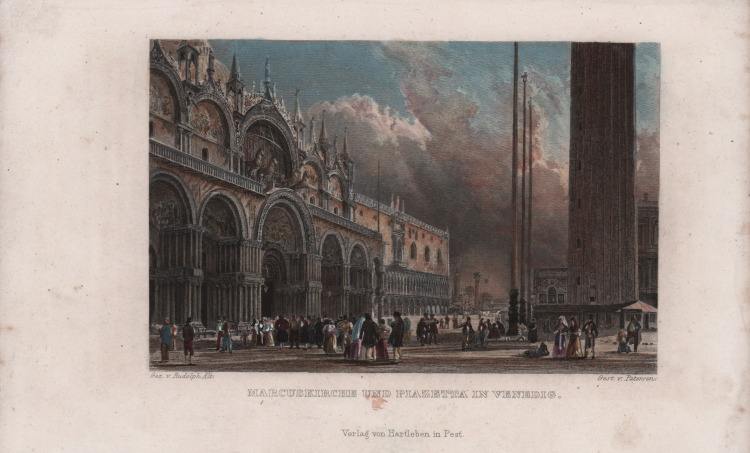


| Reference: | S47327 |
| Author | Franz Carl Weidmann |
| Year: | 1839 |
| Zone: | Venice |
| Printed: | Leipzig |
| Measures: | 225 x 145 mm |


| Reference: | S47327 |
| Author | Franz Carl Weidmann |
| Year: | 1839 |
| Zone: | Venice |
| Printed: | Leipzig |
| Measures: | 225 x 145 mm |
Veduta di Piazza San Marco tratta da un dipinto di Rudolf Alt, stampata a Lipsia.
Tratta da Weidmann, Franz Carl "Panorma der Österr. Monarchie", Perth e Lipsia 1838-40.
Acquaforte, finemente colorata a mano, in ottimo stato di conservazione.
Franz Carl Weidmann (Vienna 1787 - 1867)
|
Franz Carl Weidmann (1787 or 1788[1] – 28 January 1867) was an Austrian writer, actor and journalist.
Born in Vienna, Weidmann was the son of the actor and writer Joseph Weidmann (1742–1810) and nephew of the playwright Paul Weidmann (1746–1810). Since he wasn't particularly talented as an actor, he voluntarily ended his father's initiated engagement at the Wiener Hoftheater and got a small pension for it till the end of his life. As a freelance writer he gained some recognition because of his modest, unobtrusive manner, among others by his Sämmtliche Werke; published from 1821 to 1822, the first volume with four historical dramas, the second with poetry, and the third with the Memorabilien aus meiner Reisetasche. Thanks to the support of Archduke Johann, from this third volume onwards he wrote in particular descriptions of the surroundings of Vienna and the Austrian Alpine landscapes, Dalmatia and Montenegro with a mixture of topographical information and his own inventions. However, his good friend Adolf Bäuerle, in whose Wiener Theaterzeitung he wrote some theatre reviews, noted that Weidmann never got out of the Österreichischen Erblanden, so that many of his travelogues would have originated only from fantasy, namely the announced descriptions of Egypt and Syria.
He was more successful as a Viennese chronicler, reporter, obituarist, and theatre and art critic who worked for decades. As a journalistic "girl Friday", his contemporary nickname, he published the Oesterreichischer Zuschauer in 1854 after the death of Josef Sigmund Ebersberg, even if only for a short time. Mainly he wrote reviews for the aforementioned Wiener Theaterzeitung, Johann Schickh [de]'s Wiener Zeitschrift für Kunst, Literatur, Theater und Mode [de] and other magazines. As a reviewer he was prolific. He wrote about theatre and opera performances, painting, sculpture, fashion, and industrial architecture. Nevertheless, there was no financial success for the rest of his life, so he had to live off his small pension as an actor. At an advanced age he claimed to have been born six to seven years earlier and therefore older. His funeral expenses were paid by an unknown high-ranking personality at his written request. Weidmann was a member of the famous Viennese artist society "Die Ritter von der grünen Insel" (The Knights of the Green Island), to which the composer Franz von Suppé, the painter Eduard Swoboda and the Burgtheater actor Konrad Adolf Hallenstein belonged, under the direction of the playwright Otto Prechtler, along with many other artists.
|
Franz Carl Weidmann (Vienna 1787 - 1867)
|
Franz Carl Weidmann (1787 or 1788[1] – 28 January 1867) was an Austrian writer, actor and journalist.
Born in Vienna, Weidmann was the son of the actor and writer Joseph Weidmann (1742–1810) and nephew of the playwright Paul Weidmann (1746–1810). Since he wasn't particularly talented as an actor, he voluntarily ended his father's initiated engagement at the Wiener Hoftheater and got a small pension for it till the end of his life. As a freelance writer he gained some recognition because of his modest, unobtrusive manner, among others by his Sämmtliche Werke; published from 1821 to 1822, the first volume with four historical dramas, the second with poetry, and the third with the Memorabilien aus meiner Reisetasche. Thanks to the support of Archduke Johann, from this third volume onwards he wrote in particular descriptions of the surroundings of Vienna and the Austrian Alpine landscapes, Dalmatia and Montenegro with a mixture of topographical information and his own inventions. However, his good friend Adolf Bäuerle, in whose Wiener Theaterzeitung he wrote some theatre reviews, noted that Weidmann never got out of the Österreichischen Erblanden, so that many of his travelogues would have originated only from fantasy, namely the announced descriptions of Egypt and Syria.
He was more successful as a Viennese chronicler, reporter, obituarist, and theatre and art critic who worked for decades. As a journalistic "girl Friday", his contemporary nickname, he published the Oesterreichischer Zuschauer in 1854 after the death of Josef Sigmund Ebersberg, even if only for a short time. Mainly he wrote reviews for the aforementioned Wiener Theaterzeitung, Johann Schickh [de]'s Wiener Zeitschrift für Kunst, Literatur, Theater und Mode [de] and other magazines. As a reviewer he was prolific. He wrote about theatre and opera performances, painting, sculpture, fashion, and industrial architecture. Nevertheless, there was no financial success for the rest of his life, so he had to live off his small pension as an actor. At an advanced age he claimed to have been born six to seven years earlier and therefore older. His funeral expenses were paid by an unknown high-ranking personality at his written request. Weidmann was a member of the famous Viennese artist society "Die Ritter von der grünen Insel" (The Knights of the Green Island), to which the composer Franz von Suppé, the painter Eduard Swoboda and the Burgtheater actor Konrad Adolf Hallenstein belonged, under the direction of the playwright Otto Prechtler, along with many other artists.
|